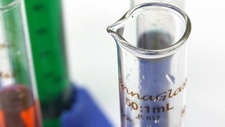Liquid Measures

TEKS Objective
The student is expected to collect, record, and analyze information using tools, including microscopes, cameras, computers, hand lenses, metric rulers, Celsius thermometers, wind vanes, rain gauges, pan balances, graduated cylinders, beakers, spring scales, hot plates, meter sticks, compasses, magnets, collecting nets, notebooks, sound recorders, and Sun, Earth, and Moon system models; timing devices, including clocks and stopwatches; and materials to support observation of habitats of organisms such as terrariums and aquariums.
Essential Understanding
The student knows how to use a variety of tools and methods to conduct science inquiry.
Science Background
Tools and Equipment of Science: BioEd Online (video) - Barbara Tharp, MS, explains what types of tools are used in the elementary classroom and how to introduce the proper usage of tools to students.
Tools and Equipment of Science
BioEd Online, www.bioedonline.org
Measuring Volume Using a Graduated Cylinder: Wisc-Online (website) – In 3rd grade, students learn how to quantify liquid measurements using the metric system and graduated cylinders. This interactive tutorial explains how to correctly use a graduated cylinder and includes practice questions at the end.
Measuring Volume Using a Graduated Cylinder
Wisc-Online, www.wisc-online.com
Signature Lesson
Measuring Colors: Julie Dubois, MSP Summer Institute (DOC) – Students use graduated cylinders and pipettes to measure and combine various quantities of food coloring. They then record these observations in a science journal. If test tubes are not available, small, clear plastic cups can be used as a substitute.
Measuring Colors
by Julie Dubois, MSP Summer Institute, www.vrml.k12.la.us
- Supporting Lessons
- Extensions
- Assessment Ideas
- Literature Connections
- Related
TEKS - Additional Resources
Supporting Lessons
Math: Volume for Elementary Level: University of Missouri (website) - This sites provide basic level information on volume and capacity. Lean about a concept of volume and measuring volume/capacity. Includes teaching ideas, games, and lesson plans.
Math:Volume for Elementary
University of Missouri, www.missouri.edu
Elaboration Lessons and Extensions
Capacity Challenge: Utah Education Network (website) – Liquid measurement tools are used to explore the concept of volume.
Capacity Challenge
Utah Education Network, www.uen.org
Measurement-Volume: Anderson County Schools (website) – Students create paper containers to compare the amount of beans it can hold.
Measurement-Volume
Anderson County Schools, www.acs.ac
Measuring Lab: Utah Education Network (website) – Following a recipe to prepare a meal requires measurement. Students work together to create a Crunchy Munchy Chocolate-Peanut Goop desert and by measuring out different ingredients from a recipe.
Assessment Ideas
Provide students with 5 different containers that can hold water. Challenge them to predict the order of the containers by the one that can hold the most liquid to the least. Allow them to test their prediction using a graduated cylinder and record the results. They can change the ranking to demonstrate what they observed.
Literature Connections
How Do You Measure Liquids? Adamson, H. (ISBN-13: 978-1429663311)
Science Toolbox, Stangl, Jean, (ISBN-13: 978-0830643523)
Science Tools, Davis, Jon, (ISBN-13: 978-1404821996)
Additional Resources
Cyber Chase Can You Fill It? PBS Kids Go! (website) – Students play a game that challenges to fill a container with the fewest numbers of pours.
Cyber Chase Can You Fill It?
PBS Kids, pbskids.org
Measuring Liquid Volume: Virginia Department of Education (pdf) - Students use a variety of tools to measure volume.
Measuring Liquid Volume
Virginia Department of Education, www.doe.virginia.gov
TEKS Navigation
Grade 3
Need Assistance?
If you need help or have a question please use the links below to help resolve your problem.

Comments